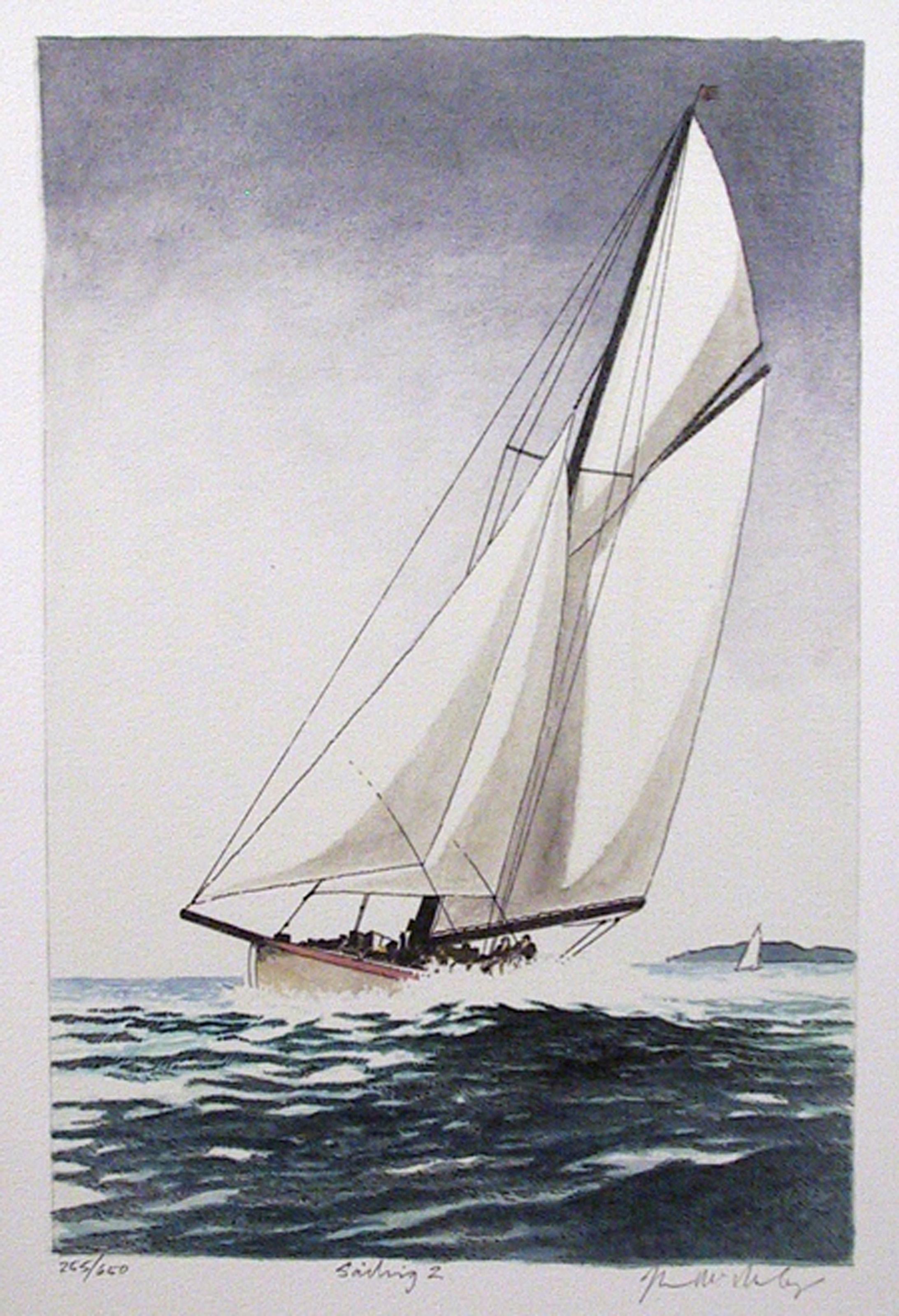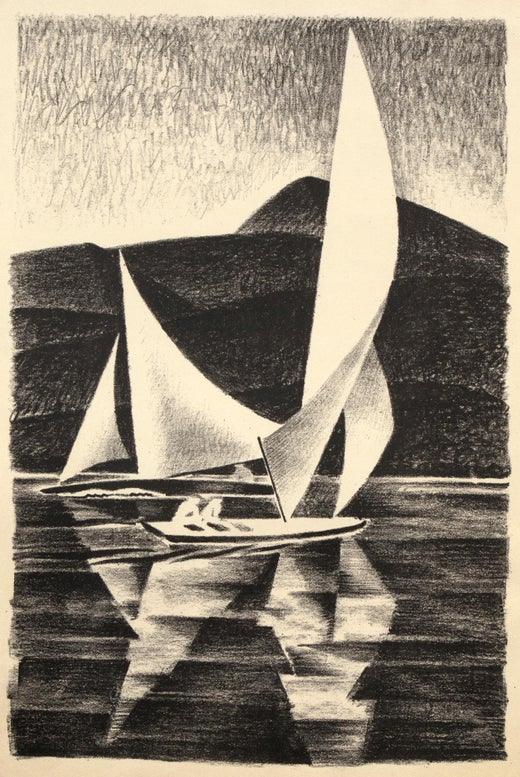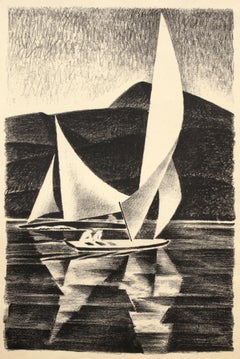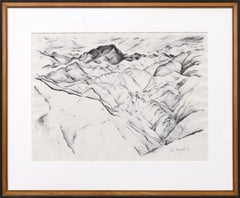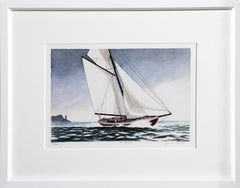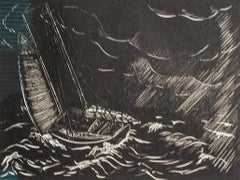Items Similar to 1933 Black & White Lithograph of Yacht Races on Grand Lake, Colorado, Sailboats
Want more images or videos?
Request additional images or videos from the seller
1 of 13
Arnold Rönnebeck1933 Black & White Lithograph of Yacht Races on Grand Lake, Colorado, Sailboats1933
1933
$1,800
£1,338.90
€1,567.58
CA$2,511.61
A$2,810.56
CHF 1,467.54
MX$34,552.95
NOK 18,514.76
SEK 17,422.30
DKK 11,695.37
Shipping
Retrieving quote...The 1stDibs Promise:
Authenticity Guarantee,
Money-Back Guarantee,
24-Hour Cancellation
About the Item
A rare and striking original 1933 black and white lithograph by noted modernist Arnold Rönnebeck (1885–1947), titled Yacht Races, Grand Lake, Colorado. This limited-edition coastal and marine print—numbered 23 of just 25—is signed by the artist and captures the dynamic energy of sailboats racing across Grand Lake, Colorado. A superb example of Rönnebeck’s Precisionist influence, it combines sharp geometric forms with the graceful movement of water and wind.
The print is professionally presented in an archival mat.
Image size (sight): 13 ¾ x 9 ⅛ in
Matted dimensions: 20 x 16 ⅛ in
Custom framing services available upon request.
Provenance: Estate of Arnold Rönnebeck
This lithograph is a significant piece of American art history and a fine addition for collectors of early 20th-century modernism, marine art, or Colorado regional works.
About the Artist:
Arnold Rönnebeck was a German-born American modernist sculptor, lithographer, and influential museum administrator. Educated in Berlin and Paris, he studied sculpture under Aristide Maillol and Émile-Antoine Bourdelle. His early avant-garde connections included Marsden Hartley, Gertrude Stein, Pablo Picasso, and Charles Demuth.
After serving as an officer in World War I and earning the Iron Cross, Rönnebeck immigrated to the U.S. in 1923. He quickly became part of Alfred Stieglitz’s modernist circle in New York and gained recognition for his Precisionist-style lithographs of American cityscapes.
In 1926, he moved to Denver, Colorado, where he served as Director of the Denver Art Museum and became a central figure in the region’s art scene. His work often depicted the American West, including the landscapes, mining towns, and Native American communities of Colorado and New Mexico.
This 1933 lithograph is an exceptional representation of Rönnebeck’s distinctive vision—bridging European modernism with the American landscape.
- Creator:Arnold Rönnebeck (1885 - 1947)
- Creation Year:1933
- Dimensions:Height: 13.75 in (34.93 cm)Width: 9.25 in (23.5 cm)
- Medium:
- Movement & Style:
- Period:
- Framing:Framing Options Available
- Condition:very good to excellent vintage condition.
- Gallery Location:Denver, CO
- Reference Number:Seller: DCG-246601stDibs: LU2738037532
Arnold Rönnebeck
Modernist sculptor, lithographer and museum administrator, Rönnebeck was a noted member of European and American avant-garde circles in the early twentieth century before settling in Denver, Colorado, in 1926. After studying architecture at the Royal Art School in Berlin for two years beginning in 1905, he moved to Paris in 1908 to study sculpture with Aristide Maillol and Émile-Antoine Bourdelle. While there he met and befriended American modernist painter, Marsden Hartley, of whom he sculpted a bronze head that was exhibited at the Salon d’Automne in Paris in 1912 and the following year at Hartley’s solo show of paintings at Alfred Stieglitz’s Gallery 291 in New York. After World War I Rönnebeck traveled in Italy with German writer, Max Sidow, and German poet, Theodor Daubler, doing a series of drawings of Positano and the Amalfi Coast that formed the basis for his lithographs on the subject. The death of his finacée, the young American opera singer Alice Miriam in 1922 and his own family’s increasing financial problems in post-World War I Germany led him to immigrate to the United States in 1923. After living briefly with Miriam’s family in Washington, DC, he moved to New York where he became part of the avant-garde circle around Alfred Stieglitz. In the summer of 1925, as the guest of Mabel Dodge Luhan, Rönnebeck first saw Taos, New Mexico, which Marsden Hartley had encouraged him to visit. It was there that he met his future wife, Louise Emerson, an easel painter and muralist. A year later they were married in New York before relocating to Denver. He served as director of the Denver Art Museum from 1926 to 1930 where he invited Marsden Hartley to lecture on Cézanne’s art in 1928. Rönnebeck fostered the development of the museum’s collection of American Indian art and the curation of modernist art exhibitions. In addition to his work at the museum, he was professor of sculpture at the University of Denver’s College of Fine and Applied Arts from 1929 to 1935, and wrote a weekly art column in the Rocky Mountain News. In Colorado, the subject matter of his lithographs became the state’s landscape and its mining towns, as well as Native Americans from the pueblos in neighboring New Mexico. By the early 1930s Colorado’s old mining towns became a popular genre for artists because they were easily accessible, and their architectural components provided a welcome break from the nineteenth-century panoramic landscape tradition and the overwrought cowboy-and-Indian subject matter of the previous generation. As an amateur actor and music enthusiast, Rönnebeck had an additional connection with Central City. In June 1947, some five months before his death, the Denver Art Museum organized a solo exhibition of his sculptures, watercolors and prints. © copyright Stan Cuba for David Cook Galleries
About the Seller
5.0
Vetted Professional Seller
Every seller passes strict standards for authenticity and reliability
Established in 1979
1stDibs seller since 2013
289 sales on 1stDibs
Typical response time: 13 hours
- ShippingRetrieving quote...Shipping from: Denver, CO
- Return Policy
Authenticity Guarantee
In the unlikely event there’s an issue with an item’s authenticity, contact us within 1 year for a full refund. DetailsMoney-Back Guarantee
If your item is not as described, is damaged in transit, or does not arrive, contact us within 7 days for a full refund. Details24-Hour Cancellation
You have a 24-hour grace period in which to reconsider your purchase, with no questions asked.Vetted Professional Sellers
Our world-class sellers must adhere to strict standards for service and quality, maintaining the integrity of our listings.Price-Match Guarantee
If you find that a seller listed the same item for a lower price elsewhere, we’ll match it.Trusted Global Delivery
Our best-in-class carrier network provides specialized shipping options worldwide, including custom delivery.More From This Seller
View All1930s Black & White Print of Grand Lake Yacht Races in Colorado Mountain Lake
By Arnold Rönnebeck
Located in Denver, CO
This vintage 1930s black and white lithograph by Arnold Ronnebeck (1885-1947), a prominent Colorado artist from the WPA era, beautifully captures the Grand Lake...
Category
1930s American Modern Landscape Prints
Materials
Lithograph
1930s Black and White Lithograph of House at Gregory Point, Colorado Landscape
By Arnold Rönnebeck
Located in Denver, CO
This original lithograph by renowned modernist Arnold Ronnebeck (1885-1947) depicts a charming home in Gregory Point, near Central City, Colorado. Created during the 1930s, this piec...
Category
1930s American Modern Landscape Prints
Materials
Paper, Lithograph
WPA-Era Central City, Colorado, 1930s Modernist Lithograph, Cityscape 3/25
By Arnold Rönnebeck
Located in Denver, CO
This 1933 lithograph, Central City, Colorado 3/25, by Arnold Rönnebeck, captures the architectural essence of a historic mining town during the Great Depression. Rendered in black an...
Category
1930s American Modern Figurative Prints
Materials
Lithograph
$1,350 Sale Price
50% Off
1933 American Art Lithograph, Clear Creek Canyon by Ross Braught, Colorado
By Ross Eugene Braught
Located in Denver, CO
This striking original lithograph, Clear Creek Canyon I (Colorado), was created in 1933 by acclaimed American artist Ross Eugene Braught (1898–1983). A master of landscape and form, ...
Category
1930s American Modern Landscape Prints
Materials
Lithograph
Vintage Colorado Mountain Landscape, Original Modernist Graphite Drawing, Framed
By Boardman Robinson
Located in Denver, CO
This original graphite on paper drawing by renowned artist Boardman Robinson (1876-1952) captures the dramatic beauty of a Colorado mountain landscape...
Category
20th Century American Modern Landscape Drawings and Watercolors
Materials
Graphite
Silver Mine, Russell Gulch, CO (12/25) 1930s American Modern Lithograph Print
By Arnold Rönnebeck
Located in Denver, CO
"Silver Mine, Russell Gulch (12/25)" is a captivating black and white lithograph by American artist Arnold Ronnebeck. The piece features a mining scene in Russell Gulch, Colorado, wi...
Category
1930s American Modern Figurative Prints
Materials
Lithograph
You May Also Like
Atlantic : Regatta of Sailboats - Original etching
Located in Paris, IDF
Rene LIGERON
Atlantic : Regatta of Sailboats
Original etching and stencil
Printed signature in the plate (pale)
On vellum 11 x 29 cm (c. 4.5 x 12 in)
Excellent condition
Category
Early 20th Century Art Deco Landscape Prints
Materials
Etching
Sailing 4, American Realist Lithograph by John McNulty
By John McNulty
Located in Long Island City, NY
John McNulty, Irish/American (1949 - ) - Sailing 4, Year: circa 1981, Medium: Lithograph, signed and numbered in pencil, Edition: 650, Image Size: 8 x...
Category
1980s American Realist Landscape Prints
Materials
Lithograph
Sailing I, American Realist Lithograph by John McNulty
By John McNulty
Located in Long Island City, NY
John McNulty, Irish/American (1949 - ) - Sailing I, Year: circa 1981, Medium: Lithograph, signed and numbered in pencil, Edition: 650, Image Size: 12 ...
Category
1980s American Realist Landscape Prints
Materials
Lithograph
"Squall, " Sailboat Maritime Scene Wood Engraving by Lowell Merritt Lee
By Lowell Merritt Lee
Located in Milwaukee, WI
"Squall is an original wood engraving by Lowell Merritt Lee. It features a rendition of a squall, a sudden violent gust of wind that often brings in rain, snow, or sleet.
Image: 6.1...
Category
1930s American Modern Landscape Prints
Materials
Woodcut
Sailing 2, American Realist Lithograph by John McNulty
By John McNulty
Located in Long Island City, NY
John McNulty, Irish/American (1949 - ) - Sailing 2, Year: circa 1981, Medium: Lithograph, signed and numbered in pencil, Edition: 450, Size: 13 in. x ...
Category
1980s American Realist Landscape Prints
Materials
Lithograph
Sailing 4, American Realist Lithograph by John McNulty
By John McNulty
Located in Long Island City, NY
John McNulty, Irish/American (1949 - ) - Sailing 4, Year: circa 1981, Medium: Lithograph, signed and numbered in pencil, Edition: 450, Size: 9.5 in. x...
Category
1980s American Realist Landscape Prints
Materials
Lithograph




